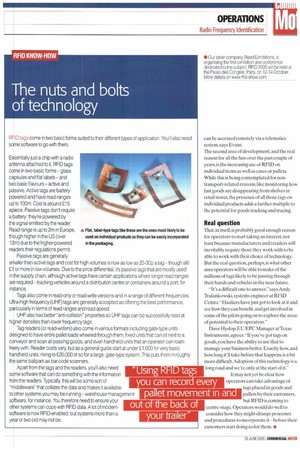RFD tags come in two basic forms suited to their
Page 55

If you've noticed an error in this article please click here to report it so we can fix it.
different types of application. You'll also need some software to go with them.
Essentially just a chip with a radio antenna attached to it, RFID tags come in two basic forms -glass capsules and flat labels-and two basic flavours active and passive. Active tags are battery powered and have read ranges up to 100m. Cost is around £15 apiece. Passive tags don't require a battery: they're powered by the signal emitted by the reader. Read range is up to 2m in Europe, A Flat, label-lype tags like these are the ones most likely to be though higher in the US (over used on individual products as they can be easily incorporated 12m) due to the higher-powered in the packaging.
readers their regulations permit.
Passive tags are generally smaller than active tags and cost for high volumes is now as low as 25-30p a tag though still E1 or more in low volumes. Due to the price differential, it's passive tags that are mostly used in the supply chain, although active tags have certain applications where longer read ranges are required-tracking vehicles around a distribution centre or containers around a port, for instance.
Tags also come in read-only or read-write versions and in a range of different frequencies. Ultra-high frequency (UHF) tags are generally accepted as offering the best performance, particularly in terms of read ranges and read speed.
UHF also has better "anti-collision" properties so UHF tags can be successfully read at higher densities than lower frequency tags.
Tag readers (or read-writers) also come in various formats including gate-type units designed to have entire pallet loads wheeled through them, fixed units that can sit next to a conveyor and scan all passing goods, and even handheld units that an operator can roam freely with. Reader costs vary, but as a general guide start at under £1000 for very basic handheld units, rising to £20,000 or so for a large, gate-type system. This puts them in roughly the same ballpark as bar code scanners.
Apart from the tags and the readers, you'll also need some software that can do something with the information from the readers. Typically, this will be some sort of "middleware" that collates the data and makes it available to other systems you may be running -warehouse management software, for instance. You therefore need to ensure your other systems can cope with RFID data A lot of modern software is now RFID-enabled, but systems more than a year or two old may not be.












































































































































































































